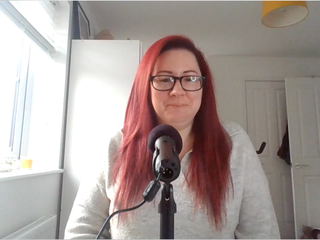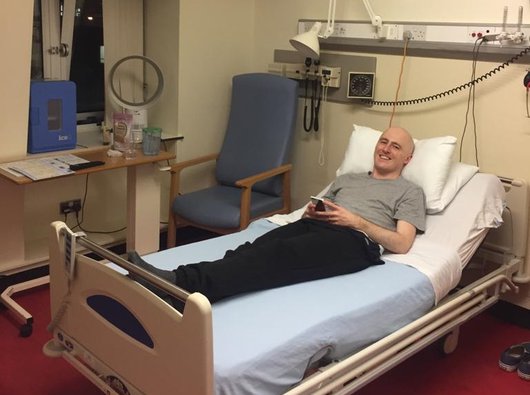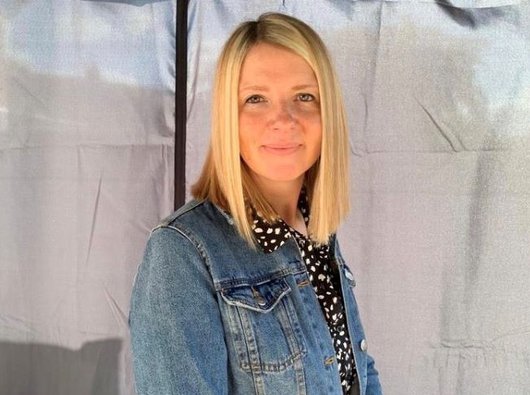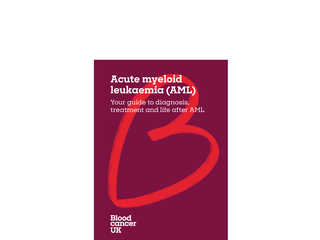Intensive treatment for AML
If your doctor thinks you are fit enough for intensive treatment, this gives the best chance of getting rid of the leukaemia permanently. Intensive treatment has two main stages: induction and consolidation.
Induction therapy
Induction therapy aims to kill as many leukaemia cells in your blood and bone marrow as possible. It usually takes around one month.
You'll be in hospital for this treatment and will have repeated infusions of chemotherapy spread over 5–10 days. The chemotherapy will damage your healthy blood cells as well as the leukaemia cells. After this treatment, it will take about three weeks for your healthy blood cells to grow back. You’ll probably stay in hospital during this time.
Once your normal blood cell counts have recovered, you’ll have blood and bone marrow samples taken, to check for leukaemia cells. If no leukaemia cells can be seen under the microscope, this means you are in remission, which is the first step towards curing AML. We explain more about what remission means on our page about measuring your response to treatment.
Some people go into remission after just one round of chemotherapy, whereas others need two rounds of chemotherapy before they are in remission.
If after two rounds of induction chemotherapy, you aren't in remission, this is called refractory AML. There are different treatment options if this happens, explained in our section about treating refractory AML.
If you do get into a remission after induction therapy, you’ll move on to consolidation therapy – explained next.
"Take things one day at a time and accept there might be setbacks – this is normal so don't worry.
"I found I had less visitors as treatment went on, so be prepared for that and take things to occupy you."
Bav, diagnosed with AML.

Consolidation therapy
If you reach remission from your induction therapy (no leukaemia cells can be seen in your bone marrow or blood under the microscope) then you'll have consolidation therapy to give you the best chance of staying in remission.
At this stage, your doctors will perform a full assessment, looking at the genetic profile of your AML and response to treatment so far. The aim of this is to work out the risk of the leukaemia coming back in the future.
If your leukaemia has a low risk of coming back, it’s likely that your doctors will recommend consolidation chemotherapy only. If there is a high risk of the leukaemia coming back, your doctors may recommend consolidation chemotherapy followed by a stem cell transplant.
Consolidation aims to stop the AML coming back by killing any leukaemia cells that may remain. Without consolidation treatment, the AML is much more likely to come back.
How long will consolidation treatment take?
Consolidation involves having more rounds (cycles) of chemotherapy, usually with similar drugs to your induction treatment.
This stage lasts several months. Each cycle of treatment lasts about one month – the chemotherapy is given over roughly one week and this is followed by a about three weeks of recovery time, similar to the induction treatment. You'll be in hospital for a lot of this, but you may be able to go home for breaks in between the rounds of treatment.

Blood Cancer Heart to Heart podcast for family and friends
"I thought this is it. I’ve driven here as your girlfriend, and I've left as a doctor, a pharmacist, a nurse, a carer - everything all rolled into one."
How will treatment affect my daily life?
Intensive treatment for AML lasts for several months. You'll be in hospital for a lot of it, and you might feel ill, from the AML or from the treatment. You'll be at a higher risk from infections during treatment too, so there might be times when you can't have many visitors. We have more information about the side effects of AML treatment and tips for coping with them.
Most people are able to spend some time at home, in between cycles of chemotherapy. This can be a welcome break from hospital and treatment, although you might still need regular blood transfusions or tests while at home.
Many people with blood cancer describe AML treatment as a rollercoaster, both for them and their family, with lots of ups and downs. Things can be hard to predict and sometimes your treatment plan might have to change.
You might find it helpful to use a health information folder to keep everything in one place and stay organised.
Other people with AML and their families have lots more tips about how they got through treatment - visit our online community forum to connect with others who've been where you are.
"Intensive treatment is tough, the side effects and the mental impact. I found watching positive videos and reading success stories of other people with AML would spur me on."
Graeme, diagnosed with AML in 2017.
Read Graeme's story about How to keep your positivity during treatment.

Which drugs will I have?
There are many different drugs that can treat AML, and research continues to find new ones.
Not everyone's AML is the same. There are different types of AML, and different drugs work for different types.
AML is caused by changes (mutations) in the DNA inside blood cells. Different drugs work against different types of AML, depending on which genetic mutations are in the AML cells.
Below we've listed some of the most commonly used drugs to treat AML, including newer drugs being looked at in clinical trials.
These are the most common chemotherapy drugs used for AML, and the combination is usually used for induction treatment.
Cytarabine and daunorubicin are both chemotherapy drugs that are given into a vein.
Daunorubicin is a red liquid. It is part of a family of drugs called anthracyclines. Cytarabine is a clear liquid.
This is a special formation of cytarabine and daunorubicin, where the drugs are wrapped in a fatty covering called a liposome. This helps protect the drugs and helps the body absorb them more slowly.
This has been shown to be more effective in people with secondary AML, AML with myelodysplasia-related changes (AML-MRC) and therapy-related AML (t-AML).
Liposomal cytarabine and daunorubicin is a purple liquid that is given into a vein.
We have more information about the different types of secondary AML.
FLAG-Ida is a combination of three chemotherapy drugs – fludarabine, cytarabine and idarubicin. They are given into a vein.
This combination is stronger than cytarabine and daunorubicin, so and may be given as induction chemotherapy to patients who are younger and fitter than usual, or who have particular subtypes of AML.
It’s also used if the leukaemia has not gone into remission (refractory AML) or if it has come back after treatment (relapsed AML). We have more information about treatments for refractory or relapsed AML.
You’ll be given injections of G-CSF with this treatment. G-CSF is a type of medicine called a growth factor. It can help your normal blood cells recover faster after treatment, and it may make chemotherapy more effective too.
Gemtuzumab ozogamicin is an antibody drug that can bind specifically to leukaemia cells and destroy them. Gemtuzumab ozogamicin works by sticking to a protein called CD33 on the surface of leukaemia cells.
Gemtuzumab ozogamicin is often given alongside cytarabine and daunorubicin as part of induction chemotherapy. It is given into a vein.
Not everyone will have Gemtuzumab ozogamicin, as not all leukaemias have the CD33 protein.
As well as being used in induction chemotherapy, cytarabine is also used for consolidation chemotherapy. In this case, it is usually given on its own but at much higher doses than in induction. The exact dose you receive will depend on your age and general health.
Cytarabine is a clear liquid that is given into a vein.
About 30% of people with AML (roughly 1 in 3) have a genetic mutation called FLT3 in their AML cells. If you have this mutation, you can have a drug called midostaurin as part of your treatment, which specifically targets cells with FLT3 mutations. Midostaurin has been shown to improve treatment effectiveness.
Midostaurin is called a targeted therapy drug because it can target the cancer cells specifically (it attacks cells with the FLT3 mutation but has much less effect on healthy cells). You take it as tablets (capsules). Midostaurin is often added to other treatments, like cytarabine and daunorubicin, or IDAC.
Midostaurin can also be taken for up to 12 months after finishing treatment, as a ‘maintenance therapy’. We explain maintenance therapy further down.
If you have the FLT3 mutation in your AML cells, you may have a drug called quizartinib alongside chemotherapy drugs as part of your induction or consolidation therapy. It can also be used on its own as a maintenance treatment for people who don't have a stem cell transplant.
Quizartinib is a type of drug called an inhibitor. It works by targeting proteins called tyrosine kinases which cause the AML cells to grow and multiply.
Quizartinib is taken as a tablet once a day.
"Compartmentalising things was my coping strategy, and it worked for a time.
"When you’re going through treatment, there isn’t always time to process the emotional side of your situation."
Read Josh's story about how AML affected him, and how he took back control.

Research and clinical trials
Clinical trials are how we find new treatments and improve current ones. Joining a trial can offer you the chance to try a new treatment before it becomes routinely available, which may or may not be better than existing treatments. Joining a clinical trial will also help improve AML treatment for other people in the future.
Below we explain some clinical trials that are happening at the moment.
This trial is comparing different combinations of chemotherapy before a stem cell transplant to improve treatment success. It is for people who are having a stem cell transplant with somebody else’s cells (a donor).
To find out more about clinical trials, contact our Clinical Trials Support Service.
Tests to check how treatment is going
During treatment, you'll have tests to monitor your AML and how you are responding to treatment. These will often be tests on your blood or bone marrow. The results of these tests will help your doctors plan what to do next in your treatment plan. We have more information about the tests and what the results mean.
"I wanted to know the whole plan upfront, but it just doesn’t work like that. You have to put your trust in your medical team and focus on what you can control."
Marie, diagnosed with AML in 2016.
Read Marie's story about Regaining a sense of control during AML treatment.

PICC lines and central lines (Hickman lines)
Lots of AML drugs are given into a vein (intravenously). To make it easier to give you treatment over several months, you’ll have a long, thin tube inserted into one of the veins in your arm or chest. This can stay in for the whole treatment plan.
When it's not being used, it will be covered with a bandage. It won't stop you doing anything, except you'll need to avoid getting it wet.
Having a PICC line or central line means you don't need to keep having injections when you have treatment or blood tests.
Stem cell transplants
Not everyone needs a stem cell transplant. But if your doctor thinks there is a high risk of the AML coming back, they might advise you to have one.
A stem cell transplant involves having cancer treatment to get rid of the leukaemia, before having new stem cells put into your body, which come from somebody else (a donor). Stem cells are very young blood cells, which can grow into new healthy blood cells in your body. This type of transplant is called an allogeneic (donor) stem cell transplant.
In effect, a stem cell transplant aims to completely replace your immune system and your bone marrow, so they can function normally again.
A transplant is an intensive treatment that can have serious complications. This is why transplants are only recommended for people who are fit enough, and when the benefits outweigh the risks.
Although a transplant carries lots of risks, it is also one of the most effective ways to cure AML.
When you have a stem cell transplant, you first need to have chemotherapy treatment called ‘conditioning’. There are two levels of conditioning you can have before a transplant:
- High doses of chemotherapy (and sometimes radiotherapy) that will wipe out all the leukaemia cells but will also wipe out your normal bone marrow (where your body makes blood cells). This method is also called myeloablative conditioning (MAC). It offers the best chance of a lasting remission, but carries more risks because of how strong the treatment is.
- Reduced doses of chemotherapy, which has slightly lower success rates in terms of people staying in remission, but carries less treatment-related risks. This method is also called reduced-intensity conditioning (RIC). It allows people who otherwise wouldn’t be able to have a transplant (because of the risks of high dose chemotherapy) to have one.
After conditioning, the new stem cells are given to you into a vein, in a similar way to having chemotherapy. Once in your bloodstream, they travel to your bone marrow and begin growing into new blood cells.
The stem cells usually come from either a family member or an unrelated donor. The donor needs to have a similar ‘tissue type’ to you. This means their genes are similar to yours. The more similar they are, the closer the match.
There are different options for stem cell donors:
- unrelated donor (from the stem cell register) – your healthcare team will look for a match on registers of volunteer donors.
- sibling (brother or sister) – a brother or sister has a 1 in 4 chance of being perfectly matched to your tissue type. They have a 1 in 2 chance of being a half-match to your tissue type.
- haploidentical donor (half-match) – your parents and children if you have them will be half-matched to your tissue type.
- cord blood (from someone who donated their umbilical cord after giving birth) – cord blood is rich in stem cells and you don’t need as close a match as with an adult donor.
Our booklet, Blood stem cell and bone marrow transplants: the seven steps explains what happens before, during and after a stem cell transplant.
The African Caribbean Leukaemia Trust (ACLT) are a charity dedicated to getting more donors on the stem cell register. They also support people and families before and after a stem cell transplant.
What other treatments might I need?
As well as the treatment you have for the leukaemia, you'll need other treatments to deal with symptoms of leukaemia and side effects of treatment. This is sometimes called ‘supportive care’.
AML and its treatment affects your healthy blood cells and immune system. You might need antibiotics to reduce your risk of getting an infection during treatment.
You will probably also need to have transfusions of red blood cells and platelets. These are taken from healthy blood donors and used to replace the cells that your body cannot make.
You may also have anti-sickness medicines, to help prevent nausea (feeling sick).

Find out more about side effects
Tips and real stories about side effects like hair loss, peripheral neuropathy, brain fog, sleep problems, infection risk, nausea and sore mouth.
Maintenance therapy
Maintenance therapy means having more long-term treatment, for one or more years, after you finish consolidation therapy and you are in remission. The aim of maintenance therapy is to further reduce the risk of AML coming back (relapse).
Maintenance therapy is not always used in AML, although it is often used for people with a FLT3 mutation who have had a complete remission after consolidation therapy.
In this case, midostaurin can continue to be taken once a day for up to 12 months with the aim of preventing relapse. Quizartinib is also an option for maintenance therapy.
Currently, only people who do not have a stem cell transplant can have maintenance treatment with midostaurin or quizartinib, although this might change in the future. Other maintenance treatments that work against the FLT3 mutation might also be considered for patients who have had a transplant.
Maintenance therapy is not usually given to other patients with AML, because at the moment there is limited evidence about how much it helps to prevent relapse, make remissions longer or improve survival. But several clinical trials are looking into this.
A drug called oral azacitidine is currently being considered as a possible maintenance treatment for people with AML who get into complete remission and are not having a stem cell transplant.
Another trial (AMADEUS) is looking at giving oral azacitidine for up to one year after a stem cell transplant.

Order your free guide to AML
If you've been told you have AML, this booklet covers treatments, questions to ask your medical team, and real stories of people living with AML.
